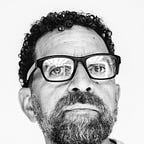It Was New. Then It Became A Part Of My Ride.
I’ve been riding with an OMATA One for 87 weeks now. In that time we’ve had three main stages of product development — from what we refer to as our “Kickstarter version”, through to our B1 and B2 pre-production builds.
The first time I put our first hand-assembled, hand-made functional prototype on my handlebars in the early Spring of 2016, I was exuberant. It was working. The simplicity of it all — on the surface at least — was compelling. You work harder to go faster and the speed hand would go up. Slow down, the speed hand would go down. Ride longer and you’d notice that the ride time hand would imperceptibly tick up, like the movement of an hour hand on a watch face. Find a climb, grind up it and the ascent hand would let you know by making its way around its dial at a pace that seemed to fit the effort to get to the top.
Then something confusing happened. I noticed that I had *stopped* noticing my OMATA One. It fell away from my primary focus. I was deeply, heavily invested in the work of making it. But here I was suddenly realizing that I wasn’t paying attention to it all the time. When did I stop noticing it?
I was shocked. It was like suddenly realizing you were walking in the rain but you hadn’t noticed the rain start to fall. How could I not be always watching, always marveling at this cool instrument sitting out in front of my handlebars?
What happened was my OMATA One became a part of my bike, a part of my ride, in a way that no other bike computer had in the past. It stopped demanding my attention and let me focus on riding my bike. I stopped noticing it in the same way I stopped noticing my shift levers after I get used to their action. The way I stopped noticing new handlebar tape after my palms get used to the new, clean, cushion-y feeling. I stopped noticing it the way I don’t notice a crank arm. My saddle. The reach to my water bottle. The sound each bike makes when I free-wheel.
My OMATA One just did the job.
We have “hidden” the digital nag of what we think of when we think “computer”. The inscrutible menus. The arguably insidious ability to endlessly tweak settings, reconfigure options and adjust backlight settings and font sizes. The pressing, swiping, dismissing, beeping, Tweeting. Watching digits flicker and notifications appear. Those computer-y things? They are not why I ride a bike. I suspect they are not why you ride a bike either.
By hiding the computer we made sure to have all the benefits of computation — satellite GPS, data storage, ANT+, Bluetooth — but constrained to the purpose of cycling without distraction. I could ride without being manipulated by a half-baked algorithm that was subtly compelling me to think about reconfiguring the layout of a screen, or take a phone call. I would not be annoyed by watching my speed flicker from 20.2 to 20.3 to 20.2, rather than smoothly be represented by the connection between my effort at pedaling and an indicator hand moving up or down. Or watching painfully as the digital minutes tick up during the first hour of what I knew was going to be a 4 hour ride.
I could just ride and feel the mechanical connection between my effort and the speed hand. The connection between legs to pedals to crank to chain to hub to wheels moving and tires making the hum they make as they stick and unstick to the road. I could just lose myself in the sounds and sensations and thoughts that occur while I ride my bike.
We designed the OMATA One to suit the core purpose of riding a bike — which is riding a bike. The OMATA One has only the most constrained level of interactivity. We have three settings at the twist of a bezel: Ride. Stop. Connect to App. We make sure all your data is recorded, including from external sensors paired over ANT+. And of course you can share it to Strava.
The OMATA One does “computer-y” things — records your ride data, records from ANT+ sensors, uploads to Strava. Etc. In that sense we may have built you a “bike computer.” To be honest, I’m not entirely sure how to refer to the OMATA One. However you think of the OMATA One, you can be sure that we made an instrument that celebrates the reasons we ride in the first place: the connection to your bike you feel when your effort turns into motion.
— Julian Bleecker. Co-Founder. CTO. Cyclist.
